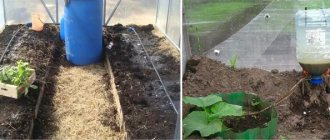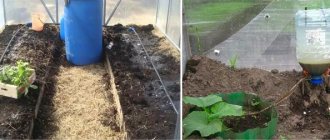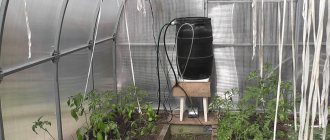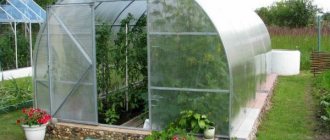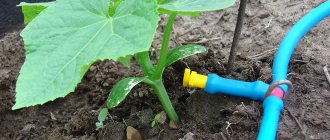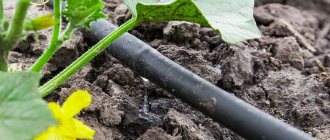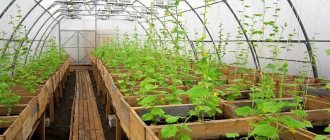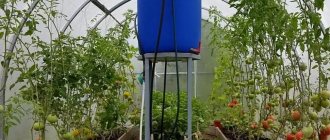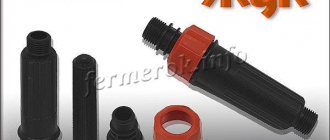By installing drip irrigation in a greenhouse, in an open area or even at home, you no longer have to water the plants manually. Therefore, any gardener and florist would not mind acquiring one. You can do drip irrigation for a greenhouse yourself; in this article we will tell you and show you how. And in the end, we will analyze the options for ready-made systems that operate from a water supply or container.
DIY drip irrigation system assembly
Homemade drip irrigation is not difficult to make.
You must perform the following steps step by step:
- The barrel (up to 200 l) is raised above the ground to a height of up to 2 m. Holes are made in the lid for air access. If it is missing, then cover it with gauze - this is protection from insects and dirt.
- A hole is drilled near the bottom, a tap-tip is installed and the hose is brought in.
- The mains are installed at a slight slope - about 5 cm for every meter. For this, additional pegs are used.
- Pipes (hoses) are not made long - it is better to build several systems. Lay out carefully, do not drag or pull.
- They ensure precise joining of pipes - they are placed in a vice before cutting. Sealed with tow or fum tape. All connecting elements fit very tightly.
- The holes are made small (no more than 2 mm). An awl or nail is suitable for a hose, and a drill for PVC pipes. If you insert pieces of wire, water will flow down them.
- Purchased devices have colored marks - they are placed upward.
- The main hose is secured with a clamp. The lines are washed to prevent blockages, and a plug - a wooden plug - is inserted.
- They check that the water reaches each dropper, and the soil is moistened evenly.
Calculation of watering time and volume of liquid supplied
The system design allows you to calculate water consumption and tank volume. Calculation example:
- highways - 15 m;
- between nozzles - 20 cm;
- required number of droppers - 1500/20=75 pcs.;
- consumption of one - 2 liters per hour;
- all nozzles - 2*75=150 l;
- barrel size - 150.
A long system will require a larger capacity, so several devices are usually made.
Individual watering times are calculated for each plant. Devices that consume 2 liters per hour include:
- cucumbers - for 60 minutes;
- tomatoes - 45 minutes;
- cabbage - 75 min.
Rules of operation, maintenance, care
Self-installed irrigation systems require periodic maintenance and proper operation.
For open ground
For irrigation systems for gardens and large areas, it is necessary to consider:
- Possible damage from garden tools, birds and rodents.
- Clogging of the system with soil and fertilizers.
The entire system must be installed efficiently. Air leaks from the outside greatly affect the overall pressure and quality of irrigation.
For the greenhouse
The most important thing when watering a greenhouse is that the water is at room temperature. This is especially important in the cold season. Therefore, it is necessary to fill the tank with water in advance, let it settle and heat up. Greenhouse irrigation systems also require regular cleaning with high pressure water.
DIY drip irrigation from plastic bottles
For a small area, the simplest system of ordinary plastic bottles is suitable.
They are hung on a peg, with the neck down, and a narrow tube or simply the refill of a ballpoint pen is inserted into it. Be sure to make a hole for air to escape.
The second option is to make holes in the bottom. Here it is important to take into account the type of soil and its ability to absorb moisture, since the number of holes depends on this:
- sandy - 8;
- clay -12.
Their size is small so that the liquid does not spill out quickly. You can make them with a needle.
A simple option is underground watering: the bottle is buried in the ground, and the neck remains above the surface. When the amount of water decreases, add it. The advantage of this method is that there is no crust on the surface that needs to be loosened. For example, in a greenhouse, one tomato bush will need 1 liter of liquid for 7 days.
The holes quickly become clogged if there is clay in the soil. To prevent this:
- put ordinary nylon tights on the part of the container with holes;
- make a little drainage - put burlap or grass in the hole before burying.
This is a good idea for people who are often away. The bottle is placed in the ground, tilted at 30-45° to reduce the water pressure and the rate of its consumption.
Main classification
The systems on the market are divided into several categories: hose and belt, operating from a separately installed container or water supply. The designs differ in the type of water supply, manual or automatic adjustment, ground or underground installation.
The choice depends on the characteristics of the site and its size, the needs of the plants, the financial capabilities of the gardener and his personal preferences.
Automation of drip irrigation
It is possible to automate a drip irrigation system so that it turns on itself on time without human intervention. To do this, use a special device - a controller (timer).
The controller, which has fittings on both sides, is inserted into the drip irrigation pipeline system. It can also be used to control water intake when connected to a pump.
It is possible to do underground irrigation - this drip irrigation is distinguished by the laying of a pipeline that is placed at depth.
Tips for use
You are convinced that making a drip irrigation system yourself is not difficult. How much cheaper it is than buying a ready-made one remains an open question. This will be easy for those who have medical workers in the family or people who can buy IVs at a discounted or wholesale price. Otherwise, the system may turn out to be quite expensive.
And finally, I would like to give some tips on using drip irrigation that will extend its service life and make it easier for you to use.
- The reservoir should only be filled with clean water to keep the filter clean for as long as possible.
- By the way, you need to clean the filter weekly even if you fill it with clean water.
- Before you first start using your drip irrigation system for its intended purpose, flush it and see if everything is working correctly. It is better to eliminate shortcomings immediately, if any.
Now you fully understand what drip irrigation is, why it is needed, and how to assemble it from ordinary droppers. The system is not complicated, but very functional. That is why do not waste your time now, so as not to run around with buckets later.
Video - How drip irrigation from drippers works
| The most familiar and understandable way. You will need a thick watering hose and thin water conduits with a diameter approximately the same as the air supply hose of a conventional pump for wheels and balls. The entire system is connected, as in the case of industrial installation, using fittings. | |
| From plastic bottles | There can be two scenarios here - the bottles can be hung near the plants or dug into the ground. In the first case, they are equipped with droppers, in the second, a lot of holes are made in them, and the upper part is cut off. The system is inconvenient because you have to add water to the bottles. |
| From a medical dropper | It is very easy to make drip irrigation from this material. Droppers are an affordable material; they can be purchased at a pharmacy or asked from a medical professional you know. |
DIY drip watering of indoor plants
When leaving for a long period, a drip irrigation system will be useful for house plants. You can choose it in the store. For example, there is a special polymer that retains liquid and then releases it.
But you can make drip irrigation for indoor plants with your own hands. A few simple ideas:
They take a plastic bottle and attach a dropper and silicone tubes. The end is closed, and holes are made along the entire length.
Wick watering - place a container of water near the pot. The wick is lowered into it with one end and buried in the ground with the other. Used for porous soil. Not suitable for tall plants because They have large roots and the moisture they receive will not be enough.
Be sure to check the operation of the system before leaving, the rate of water consumption.
Self-production
Today, gardeners use several drip irrigation options based on plastic bottles, which can be made quite easily and quickly with your own hands. It should be remembered that the version of such a system should be selected not only taking into account personal preferences in appearance, but also according to the requirements for watering each individual plant being grown.
Along with sprinkling and subsoil irrigation methods, drip irrigation is very important if it is impossible to water the plants yourself every day
Review of ready-made drip irrigation systems
Many gardeners prefer to make a drip irrigation system with their own hands, but, as a rule, it is good only for not too large plantings. It is much more reliable and convenient to purchase a ready-made drip irrigation system that will serve you for many years.
We offer an overview of the most popular systems to make it easier for you to decide on the model and configuration.
"Bug"
The system got its name by analogy with a beetle - a long hose-body and many dropper legs arranged symmetrically. The manufacturer offers two types of systems, separately designed for greenhouses and greenhouses.
You will have to assemble the structure yourself; to do this, use an awl to make holes in the main hose where the droppers are inserted. True, doing this without additional lubrication is quite problematic.
Each kit comes with a special filter that prevents soil and sand from clogging the irrigation holes, but the timer is purchased separately; on the official website of the store it costs 2,186 rubles. with discount.
“Beetle” is produced both with water intake from stationary containers and from a water supply system. The system works well even at low pressure. The container irrigation kit includes a transparent tube through which you can monitor the water level in the barrel.
The manufacturer gives a choice of systems for 20, 30 and 60 plants, but, as practice shows, even the “Beetle” 30 is too small even for a classic greenhouse, while we will not consider 20 at all, although its price on the official website is only 623 rubles.
Many summer residents note that the quality of the plastic leaves much to be desired, the joints leak, and the timer has to be hidden in polyethylene to prevent water from getting inside it. The kit also includes plugs that allow you to adjust the direction of water movement and carry out selective watering, as well as a fitting that makes it possible to connect the system to almost any container that you will use as a water source. The storage container with water should be 1-2 meters above ground level.
Drip irrigation ZHUK with emitter tape
Drip irrigation ZHUK with emitter tape comes in 12 and 24 meters. Let's look at them in more detail in the table.
Drip irrigation ZHUK with emitter tape: equipment
These types are suitable for beginners, their size is small.
| System type | 12 meters | 24 meters | |
| Equipment | Main hose, m. | 4 | 6 |
| Connection connection to the container, pcs. | 1 | ||
| Fitting 1/2-3/4, pcs. | 3 | ||
| Large tee, pcs. | 2 | ||
| Level tube transparent, m. | 1 | ||
| Suspension for level tube, pcs. | 1 | ||
| Clamp for main hose, pcs. | 2 | ||
| Shilo, pcs. | 1 | ||
| Fine filter, pcs. | 1 | ||
| Crane, pcs. | 1 | ||
| Clamp for main hose, pcs. | 4 | 8 | |
| Emitter tape, m. | 12 | 24 | |
| Start fitting, pcs. | 2 | 4 | |
| Plug for drip tape, pcs. | 2 | 4 | |
| Operating pressure in the system | 0.1 - 1 atm | ||
| Emitter Ribbon Wall Thickness | 0.15 mm | ||
| Emitter Distance | 30 cm | ||
| Water flow per emitter | 1.6 l/h | ||
| price, rub. | 691 | 913 | |
Now let's look at the Zhuk systems from the water supply system :
Packaging of the Zhuk system from the water supply for 30 and 60 plants
| System type | 30 plants | 60 plants | |
| Equipment | Main hose, m. | 9 | 18 |
| Microtube, pcs. | 30 | 60 | |
| Collet tee 1/2, pcs. | 1 | ||
| Collet clamp 1/2, pcs. | 3 | ||
| Collet angle 1/2, pcs. | 2 | ||
| Compensated dropper, pcs. | 31 | 61 | |
| Arrow with clip, pcs. | 30 | 60 | |
| Fine filter, pcs. | 1 | ||
| Clamp for main hose, pcs. | 2 | ||
| Clamp for main hose, pcs. | 8 | 16 | |
| Awl for main hose, pcs. | 1 | ||
| Irrigation area (sq.m.) | 6 | 18 | |
| price, rub. | 1370 | 1923 | |
| Price with timer, rub. | 3389 | 3942 | |
Now let's look at systems that operate on capacity :
Packaging of the Beetle system from containers for 30 and 60 plants
| System type | 30 plants | 60 plants | |
| Equipment | Connection connection to the container, pcs. | 1 | |
| Main hose, m. | 9 | 18 | |
| Level tube transparent, m. | 1 | ||
| Suspension for level tube, pcs. | 1 | ||
| Supply hose 40 cm, pcs. | 30 | 60 | |
| Droppers, pcs. | 30 | 60 | |
| Small tee, pcs. | 15 | 30 | |
| Crane, pcs. | 1 | 3 | |
| Angle for main hose, pcs. | 2 | 3 | |
| Large tee, pcs. | 2 | 3 | |
| Plug for main hose, pcs. | 2 | 3 | |
| Clamp for main hose, pcs. | 16 | 18 | |
| Awl for main hose, pcs. | 1 | ||
| 1/2″ fitting (for connecting to a container), pcs. | 1 | ||
| Fitting 3/4 (for mounting the filter), pcs. | 2 | ||
| Fine filter, pcs. | 1 | ||
| Irrigation area (sq.m.) | 6 | 18 | |
| price, rub. | 1231 | 1785 | |
| Price with timer, rub. | 3251 | 3804 | |
Watch the video about the product:
Both types, from water supply and container, have the same advantages and disadvantages:
| Advantages | Easy installation, there are fastenings for fixing the central hose to the ground. Clear instructions, sufficient quantity of all elements. Possibility of unlimited expansion of the system. |
| Flaws | The timer is included in the kit for an additional fee, it will cost about 2000 rubles. Inserting the droppers into the tube requires additional lubrication. Not very high quality material. |
For those summer residents who find the number of elements in the kit insufficient as it is used, the manufacturer offers to purchase an expansion kit for drip irrigation from a container and from a water supply system Zhuk 20 plants. The only thing that needs to be taken into account is that when expanding the drip irrigation system, the container with water must be raised even higher, since the load on it has become greater (in the case of using a system from the container).
Overview of two types in tables:
Packaging of expansion kit for Zhuk tank
| Type of expander | From capacity and | |
| Equipment | Supply hose 40 cm, pcs. | 20 |
| Droppers, pcs. | 20 | |
| Small tee, pcs. | 10 | |
| Crane, pcs. | 3 | |
| Angle for main hose, pcs. | 5 | |
| Large tee, pcs. | 5 | |
| Plug for main hose, pcs. | 5 | |
| Clamp for main hose, pcs. | 20 | |
| Angle for main hose, pcs. | 2 | |
| Large tee, pcs. | 2 | |
| Plug for main hose, pcs. | 2 | |
| Clamp for main hose, pcs. | 18 | |
| Dropper type | Droppers-arrows | |
| Dripper water flow | 4 l/h | |
| Operating pressure in the system | From 0.1 to 0.2 atm. | |
| price, rub. | 443 | |
Packaging of expansion kit from Zhuk water supply system
| Type of expander | From the water supply | |
| Equipment | Microtube, pcs. | 20 |
| Arrow with clip, pcs. | 20 | |
| Compensated dropper 4l/h, pcs. | 20 | |
| Collet tee 1/2, pcs. | 1 | |
| Collet angle, pcs. | 1 | |
| Clamp for main hose, pcs. | 2 | |
| Clamp to the soil, pcs. | 8 | |
| Dropper type | Compensated droppers Dr.Drop | |
| Dripper water flow | 4 l/h | |
| Operating pressure in the system | From 1 to 4 atm. | |
| price, rub. | 623 | |
You can also purchase separately:
- Main hose 20 m – 567 rub.
- Connecting coupling 1/2 - 1/2 - 40 rub.
- Collet angle 1/2 – 43 rub.
- Collet tee 1/2 - 1/2 - 1/2 - 63 rub.
- Irrigation filter – 239 RUR.
- Fitting for a barrel – 87 rub.
- Clamps for the main hose (2 pcs.) – 54 RUR.
- Clamps for the main hose (4 pcs.) – 21 RUR.
- Awl for the main hose (1 pc.) – 53 RUR.
- Arrows for drip irrigation from a container (10 pcs.) – 110 rub.
- Large tee for drip irrigation from a 1/2″ container (5 pcs per package) – 59 RUR.
- Supply hoses for drip irrigation from a container (4 m in a coil) – 176 rubles.
- Corner for drip irrigation from a 1/2″ container (5 pcs per package) – 53 RUR.
- Small tees for drip irrigation from a container (5 pcs per package) – 26 rubles.
- A set of 1/2-3/4 fittings for watering from a container (2 pieces per package) – 54 rub.
- Tap for drip irrigation from a container (1 piece per package) – 87 rub.
- Compensated drippers for drip irrigation from water supply (10 pcs. per package) – 365 rub.
- Arrow with a clamp for drip irrigation from a water supply system (10 pcs. per package) – 130 rub.
- Micropipe for drip irrigation from a water supply system (10 pcs. per package) – 143 rubles.
Website: firm-tsikl.rf
"AquaDusya"
The Belarusian manufacturer offers a universal drip irrigation system “AquaDusya” of two types - for 50 and for 60 plants. There are kits without automation, and there are automatic systems that allow you to forget about watering the beds for the season. All automatic elements of the system operate on batteries, so there is no need to be afraid of power surges.
AquaDusya Start 50
AquaDusya Start ZhKI 50
The set is quite complete. All you have to do is pick up a barrel and lift it 20 cm from the ground for Start +50 and 3 m for AquaDusya WATER TAR. The main advantage of the system, which is noted by all users, is the long service life and reliability of the structural elements.
AquaDusya Start 60
AquaDusya WATER TAR
| System type | Start +50 | Start LCD | AquaDusya +60 | AquaDusya WATER TAR | |
| Hose length, m. | 15 | 12 | 15 | ||
| Equipment | Hose 7/9 mm, m. | 2 | — | — | |
| Supply hose 7/9 mm, m. | 15 | 12 | 15 | ||
| Hose 12/15 mm, m. | 2,5 | 3 | — | — | |
| Hose 14/12 mm, m. | — | 3 | |||
| Hose 4/6 mm, m. | 10 | 12 | |||
| Droppers, pcs. | 50 | (compact) 60 | |||
| Large tee, pcs. | 1 | ||||
| Small tee, pcs. | 25 | 30 | |||
| Hose clamps, pcs. | 4 | — | — | ||
| Pump block, pcs. | 1 | — | — | ||
| Electronic starting device, pcs. | 1 | — | — | ||
| Corrugated protective tube, pcs. | 1 | — | — | ||
| Bracket, pcs. | 1 | — | — | ||
| Faucet timer, pcs. | — | — | 1 | ||
| Water intake | From container | From a container, from a water pipe | |||
| Irrigation area, sq.m. | 18 | 21 | |||
| Water consumption | 200 l/h | 125 l/h | — | — | |
| Timer | + | — | + | + | |
| Water flow regulator | + | — | — | — | |
| Connector for connection | + | + | + | + | |
| Watering mode | Every 6/12/24 hours, every 3, 4 days, once a week | — | Every 6/12/24 hours, every 3, 4 days, once a week | ||
| Lifting the container | 20 cm. | 2.5 m. | 3m. | ||
| Water consumption per dropper | 4 l. | 2.5 l. | — | — | |
| Hole spacing | — | — | — | 40 mm. | |
| Maximum pressure | — | — | — | 4 bar | |
| price, rub. | 5000 | 5500 | 1800 | 3100 | |
| Advantages | Automatic controller, reliability, designed for many landings. Now they are releasing the Start option for 70 plants, with the possibility of expanding to 100. | Budget price, long service life | You can set launch time intervals both by day and by hour. Reliability of the design. Can be used for underground installation. A more modern model, Water Tap 2, has been released. | ||
| Flaws | There is no way to connect to the water supply, not enough hoses, price. | No automation, no water connection | There may not be enough hoses for a large area; you will have to purchase them additionally. | ||
The manufacturer also produces automatic machines for greenhouse ventilation under the DusyaSan brand.
Website: aquadusia.ru
"Istok" CPC
The Samara drip irrigation system is designed to draw water from a container and a water supply system. Its kit includes drip tape and fittings for fastening, and the more modern modification of the KPK 24K is equipped with a controller for organizing automatic watering, which runs on three AA batteries. If desired, you can choose one of the available 16 programs, and place the drip tape itself both on top of the soil and inside it.
| System type | Istok KPK-100 | Istok KPK-24/24K | |
| Length of drip tape, m. | 100 | 25 | |
| Equipment | Water tap, pcs. | 1 | Tape, fittings, filter/controller |
| Reusable water purification filter, pcs. | 1 | — | |
| Adapters, pcs. | 4 | 2 | |
| Tees, pcs. | 9 | 3 | |
| Corners, pcs. | 2 | 1 | |
| Drip tape emitter type 16 mm, m. | 100 | 25 | |
| Retaining ring, pcs. | 11 | 4 | |
| Ring sealing | 1 | — | |
| Adapter, pcs. | — | 1 | |
| Irrigation controller, pcs. | — | 1 (24K only) | |
| Water intake | From a container, water pipe | From container | |
| Irrigation area | 100 sq.m. | 25 sq.m. | |
| Watering range | — | 0.3 m | |
| Water consumption | 1.4 l/h | ||
| Hole spacing | 300 mm | ||
| Connector for connection | + | + | |
| Timer | — | + | |
| Lifting the container | At least 1 m. | 8 m. | |
| Maximum pressure | 0.8 atm. | ||
| Price, rub | From 2000 | From 1000 | |
| Advantages | Large area, easy installation. | Budget price, it is possible to purchase a controller (about 2000 rubles). Designed for 83 plants. | |
| Flaws | There is no possibility to connect to the water supply in the basic configuration. | ||
Website: www.istokpkf.ru
"Water strider"
The manufacturer from Dubna offers two system options - Vodomerka-Eco (a budget irrigation option) and Vodomerka. The difference between them is that the latter has a battery-powered controller that allows you to automate the system without requiring human intervention.
Water strider IVF
Water strider
This design only works with a container; connection to a water supply is not possible. A barrel of water, as summer residents note, should be plastic for ease of fastening; a prerequisite is to raise the container by about 50 cm above ground level.
Watering sensor
Hose, droppers
Another advantage of this system is the presence of a ball valve rather than a membrane valve, which allows it to work properly at any pressure. If necessary, it is possible to supplement the basic version with an extension kit, which allows you to capture another 2 meters of beds.
| System type | Water strider | Water Strider-Eco | |
| Hose length, m. | 12 | 12 | |
| Equipment | Starting device, pcs. | 1 | — |
| Hose, m. | 12 | ||
| Crane, pcs. | 1 | ||
| Shaped connector, pcs. | 1 | — | |
| L-shaped connector, pcs. | 2 | — | |
| Connector, pcs. | 2 | Specified set. | |
| Filter, pcs. | 1 | ||
| Hose pegs, pcs. | 4 | — | |
| Hole punch, pcs. | 1 | — | |
| Droppers, pcs. | 40 | ||
| Microtubes 50 cm, pcs. | — | 40 | |
| Water intake | From container | From container | |
| Irrigation area, sq.m. | 12 | 12 | |
| Maximum pressure | 1 bar | — | |
| Timer | + | — | |
| Connector for connection | + | + | |
| Watering time | 2-120 min | — | |
| Interval | 6 hours – 7 days | — | |
| price, rub. | 3000 | 1300 | |
| Advantages | Automatic controller, reliability. | Budget price, long service life | |
| Flaws | There is no way to connect to the water supply, cost, fittings are only suitable for plastic barrels | ||
Website: msk.teplicy.ru
"Signor Tomato"
developed several configuration options for the same drip irrigation system “Signor Tomato”.
A simple option - emitter tape and fittings 24
The simplest option is emitter tape and fittings. The footage can be selected from 24 to 100 meters. Such a system is attached to a barrel raised above the ground, and the tape itself is placed on top of the ground.
A simple option - emitter tape and fittings 50, 100
Another configuration option includes not a tape, but a drip tube with branching hoses, designed for 60 plants. If desired, you can additionally purchase a timer.
"Signor Tomato" with drip tube for 60 plants
And today’s most modern variation of “Signora Tomato” is a fully automated drip irrigation system powered by solar panels. In addition, it is already equipped with a submersible pump, so there is no need to additionally raise the water container above the ground.
"Signor Tomato" automatic watering system
“Signor Tomato Eco” in the table
| System type | 24 meters | 50 meters | 100 meters | |
| Emitter tape, m. | 24 | 50 | 100 | |
| Equipment | Emitter type tape | 1 | ||
| Tap | 1 | |||
| Tee for irrigation tape, pcs. | 4 | 5 | ||
| Plug for tape, pcs. | 4 | 5 | ||
| Repair fitting, pcs. | 1 | 2 | ||
| Plug for hose, pcs. | 1 | |||
| Water intake | From container | From container | — | |
| price, rub. | From 650 | From 950 | From 1350 | |
| Advantages | Easy to install. Budget price, long service life with proper care. | |||
| Flaws | At the end of the season, it requires washing and blowing, and needs proper storage. | |||
Other more expensive options:
| System type | Signor tomato 60 | Signor-tomato machine | |
| Equipment | Supply hose 7/9 mm, m. | 18 | |
| Hose for droppers 4/6 mm, m. | 12 | 17 | |
| Large splitter with plug, pcs. | 1 | ||
| Small splitter, pcs. | 3 | 30 | |
| Dropper, pcs. | 60 | ||
| Insert for barrel, pcs. | 1 | — | |
| Adapter for insertion, pcs. | 1 | — | |
| Plug for supply hose, pcs. | 3 | ||
| Solar battery | — | 1 | |
| Controller | — | 1 | |
| power unit | — | 1 | |
| Pump | — | 1 | |
| price, rub. | 1600 | 5900 | |
| Advantages | Reliable design, long service life, it is possible to purchase an additional timer | Completely autonomous system. Powered by a solar battery, supplemented with a pump. | |
| Flaws | Price | ||
Website: signor-tomato.rf
"A drop"
This drip irrigation system is an emitter tape with a complex arrangement of droppers inside. It practically prevents clogging when watering from a container or water supply, but if you plan to take water from a well, you will need an additional filter.
“Drop” involves manual switching on and off; the kit includes plugs that allow you to water only selected beds.
The system is additionally equipped with a function that allows you to add fertilizers to the water to increase the yield of your crops.
The manufacturer offers methods for connecting both to the water supply and to the barrel for water intake.
| System type | A drop | |
| Tape length | 50 m | |
| Equipment | Drip tape, m. | 50 |
| Crane with bunks 1/2″ thread for hose, pcs. | 1 | |
| Triplets for garden pipe and drip tape, pcs. | 4 | |
| Repair connection for drip tape, pcs. | 2 | |
| Plug for garden pipe/hose, pcs. | 1 | |
| Water intake | From a container, water supply, well. | |
| Maximum pressure | 1 atm. | |
| Irrigation area | 25 sq.m. | |
| price, rub. | 1399 | |
| Advantages | Variable method of water intake, reliable design, ease of installation, function of adding fertilizers to water, operation with low liquid pressure. | |
| Flaws | No controller or filter. | |
Website: bashagroplast.com
From a container or from a water supply - what is the difference, what and when to choose?
When planning to design an irrigation system yourself, it is important to think about where the water supply will come from.
Capacity
Using a container is the simplest option. The advantages of this option are the following:
- simplicity of design;
- ease of calculating total water consumption;
- no need to use a filter;
- the water is much warmer than tap water;
- possibility of using a container for supplying fertilizers.
Minuses:
- deterioration of water quality in the hot season - it turns green and accumulates sediment;
- water from a container installed on an elevated surface is supplied under constant pressure of 0.2 - 0.4 atm;
- During the winter season there is a possibility of icing.
For large areas with a complex irrigation system, it is better to use a water connection.
From the water supply
The advantages of this installation:
- water is supplied under constant pressure up to 5 atm;
- there is no need to replenish the container;
- the water is always clean and fresh;
- there is no need to purchase a pump.
Flaws:
- the need to install a filter;
- low water temperature in the cold season;
- the need to install a separate fertilizer tank, with its complete installation.
How to choose ready-made drip irrigation
All gardeners are divided into two types - those who permanently live in the country and those who come only on weekends and less often. When choosing a drip irrigation system, this fact must be taken into account. If you manage to get out to the dacha only a few times a month, purchase automated systems, taking additional care to ensure that the intake tank is filled with water on its own in a timely manner. The tank or barrel from which water enters the system must be in the sun; ice watering is detrimental to the roots.
The distance between the holes should correspond to the distance between plantings in the greenhouse. The most optimal step for crops familiar to our greenhouses is considered to be a step of 30 cm.
The average throughput of drippers for vegetable crops should be from 1 to 1.5 liters of water per hour. For trees, this figure is at least doubled.
Manufacturers offer three main types of drip irrigation system tapes:
- Slotted - inside it there is a branched channel that slows down the rate of water supply, which allows it to warm up evenly and not over-wet the plants.
- Emitter - flattened droppers are built inside it along its entire length. It is the most reliable type of tape today.
- Labyrinth - practically not used in modern designs due to unreliability and painstaking installation.
If a hose rather than a tape is used, then droppers are used. We discussed the types above.
Irrigation for benefit
Despite the widespread use of other methods, it is the use of drippers for drip irrigation that has gained popularity due to numerous advantages:
- ensuring access of moisture to plant roots;
- creating a favorable microclimate in the soil;
- saving fluid;
- uniform distribution of moisture throughout the bed;
- protection from disease and rot;
- Possibility of round-the-clock plant care;
- no need to waste time and effort.
The main and most important advantage of drip irrigation can be considered the elimination of physical labor in the process of caring for plants. Considering that hot weather requires timely daily watering of plants, saving your time will be significant.
The essence of drip irrigation with drippers is the construction of a structure that allows you to direct liquid directly to the root system of your plants.
A dosed supply of water will help to constantly maintain moisture in the soil in the required proportions.
Advantages and disadvantages of the drip system
The initial goal when creating drip irrigation was to compensate for the insufficient amount of water for irrigating plants. Later it turned out that this method is preferable to traditional means. The following advantages are noted:
- saving water resources - there is no expense for row spacing;
- obtaining early harvests - the development period is reduced, the fruits ripen quickly;
- saturation of the root system - slow moisture supply ensures
- rapid growth and obtaining more nutrients;
- reducing the possibility of soil waterlogging - the risk of developing diseases (powdery mildew, various types of rot, black leg, etc.) is reduced;
- no burns on the leaves - water goes directly to the root;
- reduction in the number of weeds - there is no excess moisture;
- no risk of soil erosion - best aeration;
- increase in yield by 30-40%;
- application of mineral and organic fertilizers during irrigation.
At first, this system was installed only in greenhouses or greenhouses, but later it began to be used in open areas.
However, drip irrigation also has disadvantages:
- Control over devices - incorrect calculation of water flow will lead to excess moisture and death of plants. You need to monitor the filling of the barrel. To ensure automatic watering, a timer is installed.
- Cleaning the holes - they become clogged due to their small diameter. You can't increase it, because... water will flow out without reaching all the nozzles. Use a filter installed at the beginning of the system (a piece of foam rubber), which can be removed and washed.
- The barrel and the receiver-distributor must be covered - this protects from debris and insects.
Making a simple system
- Preparation of ordinary plastic bottles through which the process of watering greenhouse plants is carried out. The best option is to use two-liter containers.
- Make several holes in the lid, the diameter of which is about two millimeters. It is through them that the plant roots are fully and progressively saturated with the required amount of moisture.
- If you have sandy soil, you can make only two holes with your own hands, but clay soil requires making at least four holes.
The easiest way to get high-quality holes in a bottle cap is to use a nail, which should be thoroughly heated. Today, a special type of pegs is being sold that perfectly replace lids. The use of such elements greatly facilitates the preparatory process. The next step is to cut off the bottom of the bottle. It is advisable to make the cut not all the way and then the container will receive a kind of lid that will effectively prevent the evaporation of moisture and clogging of the water.
Next, you should install the manufactured structure. The optimal time for this process is represented by the period of planting seedlings in a permanent place, but with the same success you can install the system in the greenhouse at any time. The containers are immersed in holes, which must be made no more than fifteen centimeters deep and every fifteen centimeters from the plant. The bottle is inserted with the lid down, maintaining an angle of forty or forty-five degrees. All manipulations with your own hands must be done with the utmost care, without damaging the root system of greenhouse plants.
When installing the system, the containers are immersed in holes, which must be made no more than fifteen centimeters deep and every fifteen centimeters from the plant. The bottle is inserted with the lid down, maintaining an angle of forty or forty-five degrees
Types of drip irrigation
Several popular options for homemade drip irrigation:
Barrel - a tank with lines diverging from it from long hoses. The container is raised above the ground to a height of up to 2 m, which allows the liquid to fill all the guides and reach its destination.
Barrel irrigation
Bottle - plastic containers. Small holes (1-3 mm) are made in the bottom, and liquid is added as it is consumed.
Bottle watering
Install close to plants.
Bottle watering
Droppers - several pieces are fixed on a horizontal peg made of wood, metal or plastic.
The flow of water is regulated by a catheter directed under the root.
Plastic pipes - laid between rows and connected to a reservoir with liquid or a central water supply. Holes are drilled closer to the stems.
Plastic pipes
Components of an irrigation system and their characteristics
The main element of the system is the water supply source. It can be represented by a water supply system, a well or a water-measuring tank, which is installed at a height of at least 1.5 m. The next required element is a filter for drip irrigation with your own hands, thanks to which the system will not become clogged with various small debris.
Automatic watering system: how to make automatic watering at your dacha (read more)
The device can be vortex, disk or mesh. The latter option is considered more popular, which is due to its low cost. The vortex filter is used for irrigation systems of large areas. The disk element is characterized by excellent performance characteristics and high cost, which is not at all justified for small summer cottages.
Metal or plastic pipes are used to transport water.
If the source of water supply is a well or well, the system must be equipped with a pumping unit. The most appropriate option is considered to be a centrifugal type of device. The DIY drip irrigation distribution network consists of pipelines and hoses. For the main trunk network, metal or plastic pipes can be used. Metal products are strong, reliable and durable. However, the material is subject to corrosion, which will result in damage to the system.
Polyethylene or polypropylene pipelines are a more acceptable option. The products are characterized by strength, a smooth inner wall, which eliminates the possibility of deposits forming inside the system. Plastic pipes can withstand temperature fluctuations and the negative effects of aggressive substances.
Types of droppers
External drippers are specially manufactured devices for inserting into laid pipelines. Their ends are small tubes that allow you to regulate the amount of water supplied.
There are three main groups of droppers, differing in design.
Adjustable
With real water consumption. It is installed according to the instructions.
There are also unregulated ones.
Uncompensated
There is less water at the end of the bed than at the beginning. Suitable for flat terrain or with slight elevation changes.
Uncompensated drip
Compensated
The liquid is dispensed in doses (there is a membrane, a valve). Ideal for use in areas with different levels.
Compensated drip
Droppers-spokes, arrows
This is a plastic tube in the form of a stand, in which there are channels through which water flows. Connect using adapters and splitters. Branched - for several plants at the same time (spider).
Anti-drainage
In addition, droppers can be anti-drainage. Water is present in the system even when the supply is stopped. This speeds up the restart, because no need to remove air.
Anti-drainage drip
It must be possible to disassemble. The cap is usually removed to clean when clogged.
Features of using drip tubes with external droppers
The drip tube is made of HDPE and is rigid and durable. It is produced without holes and is intended for self-installation of external drippers. The wall thickness of the product is 0.9-1.2 mm. The material is resistant to UV rays. The drip tube can withstand pressure up to 6 bar.
Drip tubes are rigid and durable and can withstand pressures up to 6 bar.
External drippers are used when organizing drip irrigation at a dacha individually for each plant. To ensure normal operation of the system, it is necessary to have high pressure in the network. These devices can be connected through thin hoses or connected directly to the drip pipe.
There are several types of external IVs. Compensated ones are used for uniform irrigation with a very long drip tape, as well as in areas with a slope. They operate exclusively from a pressure system. Less prone to contamination by small debris. Uncompensated devices are used with a short length of drip pipe and on flat areas. This option is used for gravity flow systems from a tank. They can operate at low network pressure. There are also dropper pegs that are used for spot watering. The product is installed in the root zone of the planting.
On a note! For drip irrigation of tomatoes, cucumbers, eggplants and peppers, it is advisable to use drip tubes with external droppers.
The advantage of such pipes is that you can independently choose the installation step and regulate the volume of water released. The disadvantages include the high cost of the product (compared to drip tapes), the labor-intensive and time-consuming process of cleaning the droppers.
Drip tubes are commonly used for watering tomatoes, cucumbers, peppers and other vegetables.
Planting plants with drip irrigation
Creating a system begins with drawing up a planting scheme - a drawing with the indicated sizes of beds and intervals between seedlings.
This allows you to take into account all the features, requirements for the amount of water and soil moisture, and calculate the required fluid consumption per day.
Some parameters are collected in the table:
| Plant | Amount of water per day, l | Distance between bushes, cm |
| tomatoes | 1,5 | 30 |
| cucumbers | 2 | 20 |
| cabbage | 2,5 | 40 |
Nozzles (sprayers) should be near each plant.
